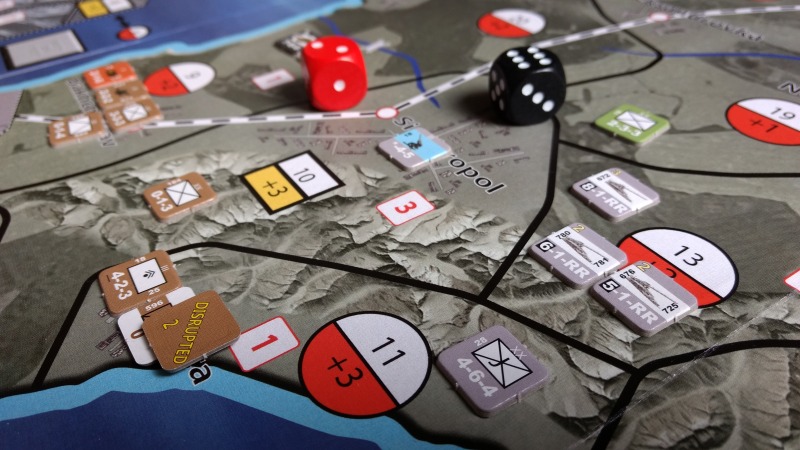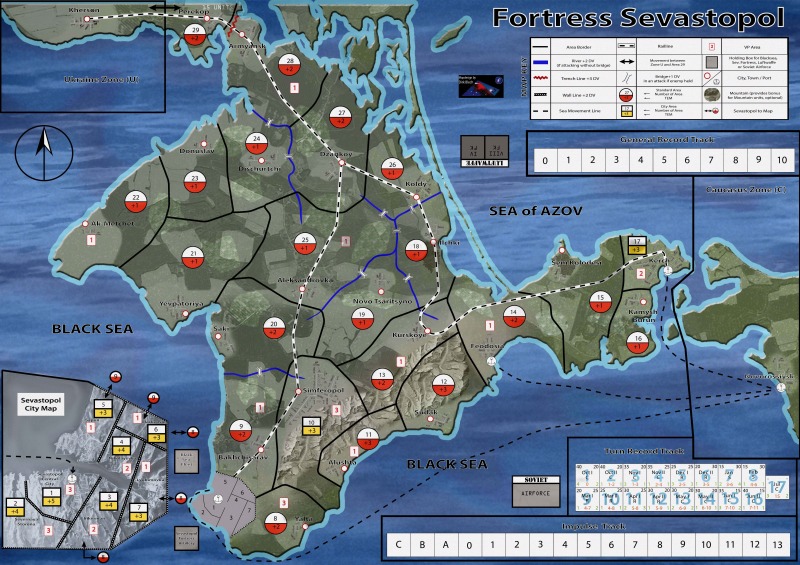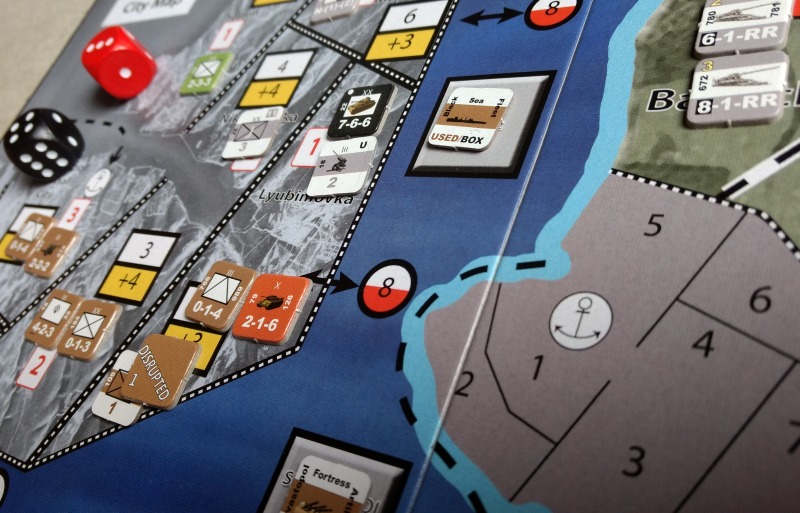
Konfliktsimulationen, auch aus Deutschland, sprechen ja primär ein internationales Publikum an. Aus diesem Grund war Norbert Franz von
"Krakka-thoooom!" Geek News & Geschichten (Link) so freundlich, meine Rezension zu übersetzen :) From Germany, you don’t just get famous board games and roleplaying games, but also several ambitiously crafted conflict simulations (
or, simply put: war games) – for example, two games that were each awarded the SILBERNER STEPHAN Reader’s Choice Award, i.e. “Hindenburg's Hour: The Tannenberg Campaign 1914” (
award winner in 2017) and “STRATAK WARS – Der Auftakt” (
award winner in 2016). These certainly constitute a niche market; however, it is a niche market which can hold its own in the middle of international competition these days. Among the most important publishing companies of the German wargaming industry, there undoubtedly is the
Udo Grebe Gamedesign Company (link), who have directed their attention to a WW2 theater of war rather infrequently observed in conflict-simulation games, in the shape of “Fortress Sevastopol” by Christian Diedler.

From a rule design point of view, “Fortress Sevastopol” rates as a medium-complexity, asymmetrical conflict simulation written for two players, in which the forces of the Axis Powers (
Nazi Germany and Romania) are tasked with the conquest of the Soviet Black Sea fortress named Sevastopol. For this endeavor, they are given a total of (
in the longest of the three Scenarios) 17 rounds’ time, corresponding to the real-world period from October 1941 to July 1942. But how exactly does one of those rounds play out?
(1) You start the game with the Chit Draw Phase, where every player draws event tokens/coupons, which will bring in game advantages like landmines and partisan forces. The number of these chits is always expressly predetermined, as is the precise moment in which you are allowed use them.
(2) Up next, there is the Preparation Phase, which is where you deploy reinforcements, but also remove used units from the battlefield in an historically correct fashion.
(3) In the Operations Phase, players take turns issuing their orders or impulses (with one noted exception beginning with the player of the Soviet side), for instance, movement, attack, bombardment, reactivation or regrouping. Using D6 checks, in this phase, the weather and the ending of the round are also determined.
(4) You get to keep one of the event chits, the remainder are put aside in the Chit Discard Phase.
(5) During the Refit Phase, wounded or beleaguered units can be refreshed by spending Supply Points. In this phase, too, the Soviet side’s player may start. Unutilized points are put into the reserve pile.
(6) In the Administration Phase, up to six units which were previously assigned the order or impulse to regroup are then deployed to unoccupied zones. Equally, headquarters can be repositioned, before Game Turn Indication Phase occurs, where you check for victory conditions, and readjust the weather for the following round, where applicable.

When a fight occurs, both players must check their combat range values. Those are comprised of the unit’s base value, a dozen potential modifiers for attacks and defenses, as well as a damage roll on D6. Depending on the resulting total, the losing side then takes damage and may be forced to retreat, whereas the victorious attacker might be permitted to overrun the positions. There is some time you will have to spend practicing till you have understood all the game’s mechanics. Admittedly, there is a certain requirement to intensely study the rules system. As a reward, though, you get to use a wide range of tactical options (
e.g., besides “regular” attacks and bombardments, you get to use special maneuvers like bridge demolitions/bridge reconstruction, the building of improvised fortifications in the field, or amphibious landings), which expand the unadorned A4-sized rules booklet to a total page count of 24 pages with uncounted steps “in between” and subsections. Thanks to the double-sided game aids and a
free downloadable (link) tutorial (
both are in English, as is the rules booklet), entering this game is noticeably facilitated compared to other hardcore conflict simulation games.

As was the case with my last conflict simulation,
“Medieval Conspiracy” (link; well, it is rather a complex type of board game than a war game, after all), also published by Udo Grebe Gamedesign (
who thankfully provided me with a review copy), this game once again comes in typical wargaming quality: the solid cardboard box contains, next to the large game mat, a total of 228 easily readable cardboard chits, the rulebook, two double-sided game aids, and four dice. Considering that this game is made by a very small publisher for a niche market, the price point of 35.69 Euros seems totally fair and appropriate.
 Conclusion
Conclusion:
"Fortress Sevastopol" (link) is a well-designed conflict simulation in terms of game mechanics, allowing fans of complex tactical gaming to experience a rather overlooked specific theater of operations in a timeframe of about 3 to 12 hours, depending on the scenario chosen. As with all conflict simulations, you first have to learn the ropes of the rules system. As a reward for your efforts, you are given numerous tactical options.
 Konfliktsimulationen, auch aus Deutschland, sprechen ja primär ein internationales Publikum an. Aus diesem Grund war Norbert Franz von "Krakka-thoooom!" Geek News & Geschichten (Link) so freundlich, meine Rezension zu übersetzen :) From Germany, you don’t just get famous board games and roleplaying games, but also several ambitiously crafted conflict simulations (or, simply put: war games) – for example, two games that were each awarded the SILBERNER STEPHAN Reader’s Choice Award, i.e. “Hindenburg's Hour: The Tannenberg Campaign 1914” (award winner in 2017) and “STRATAK WARS – Der Auftakt” (award winner in 2016). These certainly constitute a niche market; however, it is a niche market which can hold its own in the middle of international competition these days. Among the most important publishing companies of the German wargaming industry, there undoubtedly is the Udo Grebe Gamedesign Company (link), who have directed their attention to a WW2 theater of war rather infrequently observed in conflict-simulation games, in the shape of “Fortress Sevastopol” by Christian Diedler.
Konfliktsimulationen, auch aus Deutschland, sprechen ja primär ein internationales Publikum an. Aus diesem Grund war Norbert Franz von "Krakka-thoooom!" Geek News & Geschichten (Link) so freundlich, meine Rezension zu übersetzen :) From Germany, you don’t just get famous board games and roleplaying games, but also several ambitiously crafted conflict simulations (or, simply put: war games) – for example, two games that were each awarded the SILBERNER STEPHAN Reader’s Choice Award, i.e. “Hindenburg's Hour: The Tannenberg Campaign 1914” (award winner in 2017) and “STRATAK WARS – Der Auftakt” (award winner in 2016). These certainly constitute a niche market; however, it is a niche market which can hold its own in the middle of international competition these days. Among the most important publishing companies of the German wargaming industry, there undoubtedly is the Udo Grebe Gamedesign Company (link), who have directed their attention to a WW2 theater of war rather infrequently observed in conflict-simulation games, in the shape of “Fortress Sevastopol” by Christian Diedler.
 From a rule design point of view, “Fortress Sevastopol” rates as a medium-complexity, asymmetrical conflict simulation written for two players, in which the forces of the Axis Powers (Nazi Germany and Romania) are tasked with the conquest of the Soviet Black Sea fortress named Sevastopol. For this endeavor, they are given a total of (in the longest of the three Scenarios) 17 rounds’ time, corresponding to the real-world period from October 1941 to July 1942. But how exactly does one of those rounds play out?
From a rule design point of view, “Fortress Sevastopol” rates as a medium-complexity, asymmetrical conflict simulation written for two players, in which the forces of the Axis Powers (Nazi Germany and Romania) are tasked with the conquest of the Soviet Black Sea fortress named Sevastopol. For this endeavor, they are given a total of (in the longest of the three Scenarios) 17 rounds’ time, corresponding to the real-world period from October 1941 to July 1942. But how exactly does one of those rounds play out?
 When a fight occurs, both players must check their combat range values. Those are comprised of the unit’s base value, a dozen potential modifiers for attacks and defenses, as well as a damage roll on D6. Depending on the resulting total, the losing side then takes damage and may be forced to retreat, whereas the victorious attacker might be permitted to overrun the positions. There is some time you will have to spend practicing till you have understood all the game’s mechanics. Admittedly, there is a certain requirement to intensely study the rules system. As a reward, though, you get to use a wide range of tactical options (e.g., besides “regular” attacks and bombardments, you get to use special maneuvers like bridge demolitions/bridge reconstruction, the building of improvised fortifications in the field, or amphibious landings), which expand the unadorned A4-sized rules booklet to a total page count of 24 pages with uncounted steps “in between” and subsections. Thanks to the double-sided game aids and a free downloadable (link) tutorial (both are in English, as is the rules booklet), entering this game is noticeably facilitated compared to other hardcore conflict simulation games.
When a fight occurs, both players must check their combat range values. Those are comprised of the unit’s base value, a dozen potential modifiers for attacks and defenses, as well as a damage roll on D6. Depending on the resulting total, the losing side then takes damage and may be forced to retreat, whereas the victorious attacker might be permitted to overrun the positions. There is some time you will have to spend practicing till you have understood all the game’s mechanics. Admittedly, there is a certain requirement to intensely study the rules system. As a reward, though, you get to use a wide range of tactical options (e.g., besides “regular” attacks and bombardments, you get to use special maneuvers like bridge demolitions/bridge reconstruction, the building of improvised fortifications in the field, or amphibious landings), which expand the unadorned A4-sized rules booklet to a total page count of 24 pages with uncounted steps “in between” and subsections. Thanks to the double-sided game aids and a free downloadable (link) tutorial (both are in English, as is the rules booklet), entering this game is noticeably facilitated compared to other hardcore conflict simulation games.
 As was the case with my last conflict simulation, “Medieval Conspiracy” (link; well, it is rather a complex type of board game than a war game, after all), also published by Udo Grebe Gamedesign (who thankfully provided me with a review copy), this game once again comes in typical wargaming quality: the solid cardboard box contains, next to the large game mat, a total of 228 easily readable cardboard chits, the rulebook, two double-sided game aids, and four dice. Considering that this game is made by a very small publisher for a niche market, the price point of 35.69 Euros seems totally fair and appropriate.
As was the case with my last conflict simulation, “Medieval Conspiracy” (link; well, it is rather a complex type of board game than a war game, after all), also published by Udo Grebe Gamedesign (who thankfully provided me with a review copy), this game once again comes in typical wargaming quality: the solid cardboard box contains, next to the large game mat, a total of 228 easily readable cardboard chits, the rulebook, two double-sided game aids, and four dice. Considering that this game is made by a very small publisher for a niche market, the price point of 35.69 Euros seems totally fair and appropriate.
 Conclusion: "Fortress Sevastopol" (link) is a well-designed conflict simulation in terms of game mechanics, allowing fans of complex tactical gaming to experience a rather overlooked specific theater of operations in a timeframe of about 3 to 12 hours, depending on the scenario chosen. As with all conflict simulations, you first have to learn the ropes of the rules system. As a reward for your efforts, you are given numerous tactical options.
Conclusion: "Fortress Sevastopol" (link) is a well-designed conflict simulation in terms of game mechanics, allowing fans of complex tactical gaming to experience a rather overlooked specific theater of operations in a timeframe of about 3 to 12 hours, depending on the scenario chosen. As with all conflict simulations, you first have to learn the ropes of the rules system. As a reward for your efforts, you are given numerous tactical options. 